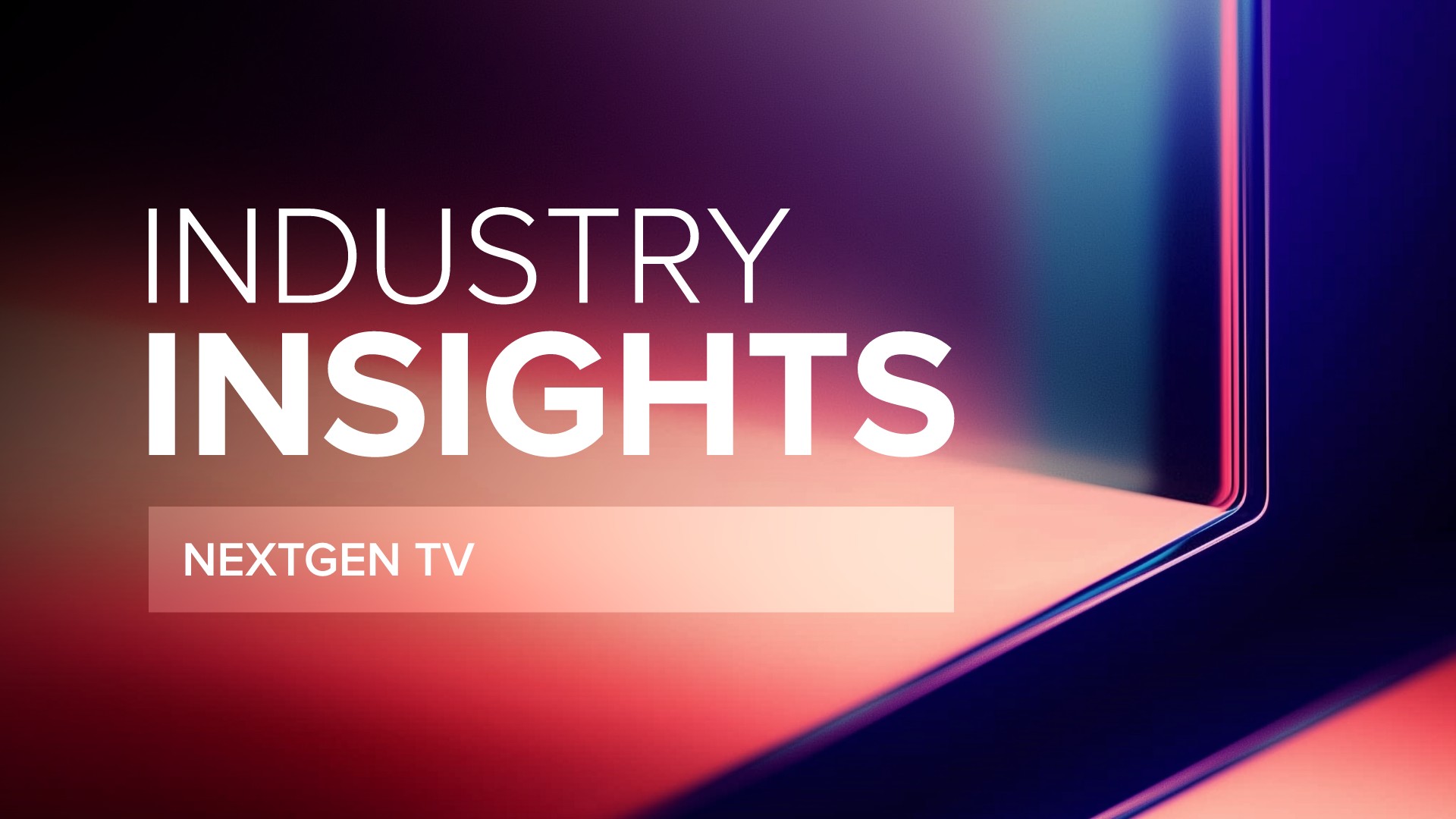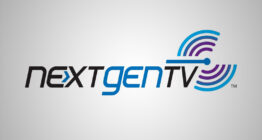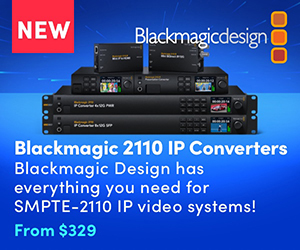Industry Insights: Challenges and opportunities with NextGen TV adoption

Subscribe to NCS for the latest news, project case studies and product announcements in broadcast technology, creative design and engineering delivered to your inbox.
As broadcast technology transforms, NextGen TV is key for local broadcasters in delivering immersive viewing experiences, personalized content and advanced interactive capabilities.
In this Industry Insights roundtable, vendors shed light on the promise and complexities of adopting ATSC 3.0.
From bridging the audience awareness gap to addressing regulatory uncertainties, experts highlight the operational and cost implications of implementing NextGen TV. At the same time, they outline how its flexibility and robust feature set — encompassing everything from datacasting opportunities to dynamic ad insertion — can unlock new revenue streams and elevate viewer engagement.
Key takeaways from this Industry Insights roundtable
- Growing awareness gap: Viewers remain largely unaware of NextGen TV’s benefits, which highlights the need for better public education.
- Regulatory hurdles: Broadcasters face challenges like spectrum sharing and uncertainty regarding an ATSC 1.0 sunset date, delaying a full switch to ATSC 3.0.
- Interactive advantage: NextGen TV’s personalization features open new revenue opportunities through targeted ads, data-driven services, and immersive viewer experiences.
- Future-proof workflows: Many see cloud-based, interoperable systems as critical for smooth transitions and cost-effective scaling.
- Enhanced audience engagement: Advanced emergency alerts, improved accessibility options, and hybrid broadcast-OTT models help broadcasters remain relevant in a competitive market.
Does the audience care about NextGen TV? Or has it missed the moment?
Costa Nikols, executive-team strategy advisor, media and entertainment, Telos Alliance: In general, we feel that the audience does not really know enough about Next Gen Audio (NGA), and it all gets mixed up with “immersive” or “surround sound.” But, based on over three billion devices sold that support Dolby Atmos, I’d say that there is both an awareness and a pent-up demand among consumers that will kick in.
Erik Otto, CEO, Mediaproxy: There are certainly still challenges ahead and obstacles to overcome but, in general, the feedback we get is very positive and there does appear to be interest in what NextGen TV might offer. As the streaming landscape continues to fragment, traditional linear platforms combined with datacasting, catch-up and other enhanced media capabilities present a unique opportunity for the industry and viewers alike. We can also hope that the new administration at the FCC will support NextGen TV more proactively
Are broadcasters missing the moment with NextGen TV?
Erik Otto: I would say not yet because it is still early days. And, being engineering driven, broadcasters are always ready to capitalize on the opportunities offered by new technologies. Whilst this means the broadcast sector is ready for NextGen TV, it does need support from the FCC and the rest of the industry to not only promote the technology to the public but also communicate its advantages.
How are broadcasters adapting their infrastructure to support NextGen TV?
Erik Otto: New tools to address the ATSC 3.0 standard are now emerging, giving broadcasters options for equitable monitoring capabilities. Being able to take advantage of extra capabilities, such as datacasting, calls for even more investment and technical foundations. Cloud and software-based approaches will certainly play a big role in helping broadcasters adapt to the changes, as well as managing the financial commitment necessary.
Steve Edwards, VP, broadcast distribution, Rohde & Schwarz: Broadcasters are adapting to NextGen TV by upgrading transmission infrastructure and finding creative ways to manage limited spectrum. Many are using the “lighthouse” model, where stations collaborate to broadcast both ATSC 1.0 and ATSC 3.0 signals, ensuring continuity while the transition progresses. Investments in new transmitters and middleware solutions are also key, allowing broadcasters to deliver hybrid broadcast-internet experiences while maintaining efficiency. At the same time, partnerships with low-power TV operators are helping expand coverage and set the stage for broader ATSC 3.0 adoption.
Tsviatko Jongov, product manager, MainConcept: Brazil and the SBTVD are the best examples of NextGen TV adoption. With their TV 3.0 standard, Brazilian regulators are mandating both video and audio requirements that include the adoption of VVC/H.266 (video) and MPEG-H Audio. We are seeing other countries, such as Japan, exploring these opportunities, and also expect to see the Brazilian efforts to be mirrored elsewhere in the LATAM region.
Suzana Brady, SVP, worldwide sales and marketing, Cobalt Digital: High dynamic range (HDR) is a key feature of NextGen TV and deploying HDR workflows is crucial as broadcasters acclimate to ATSC 3.0. Producing directly in HDR provides the most optimum approach, however, these same workflows can work for SDR as well. Legacy SDR sources and content must be integrated into the workflow and an SDR version would be created to support legacy devices.
What are the challenges of transitioning to ATSC 3.0 for broadcasters?
Erik Otto: One of the main challenges is the current absence of an FCC mandate or a confirmed phase out of ATSC 1.0. While most TV manufacturers are already supporting NextGen TV, there is a lack of education about what it will offer the consumer. The term NextGen TV promises much but it is not entirely clear what that will be.
Steve Edwards: The transition to ATSC 3.0 presents challenges for broadcasters, including spectrum sharing and regulatory uncertainty. The “lighthouse” model requires sharing limited spectrum during the transition, which restricts the rollout of new ATSC 3.0 services and revenue opportunities. Additionally, the lack of a clear sunset date for ATSC 1.0 creates uncertainty, delaying the full realization of ATSC 3.0’s potential.
Tsviatko Jongov: Most of the challenges revolve around the infrastructure upgrade, which would require investments in transmitters, encoders, and other equipment. On the other hand, only a good adoption rate in the consumer segment of ATSC 3.0-enabled devices will justify the investment in ATSC 3.0. Regardless of the challenges, the goal of ATSC 3.0 integration is clear — bringing cutting-edge technology within reach of consumers for an enhanced viewing experience.
Suzana Brady: Of course, cost always presents a challenge when transitioning from one protocol to the next. It is less painful, however, when steps are taken to maximize a single workflow that can address both protocols for a gradual deployment.
Mark Simpson, president & CEO, Triveni Digital: Transitioning to ATSC 3.0 is complex, both because of the richness of the underlying technology and the number of new revenue-bearing services that will be carried, requiring more sophisticated orchestration and monitoring to ensure seamless operation. During the transition, broadcasters must carefully manage ATSC 1.0 and 3.0 in parallel, making automation and dynamic configuration essential.
How does NextGen TV enhance the viewing experience compared to traditional broadcast standards?
Costa Nikols: NextGen Audio gives listeners a personalized and awesome audio experience, putting them right in the middle of what’s happening. With dialogue enhancement, every word is super clear, so viewers don’t have to rewind, and won’t miss out on important parts. NGA lets viewers control their experience, offering commentary and audio track options tailored to what they like.
Erik Otto: Consumers will have higher picture quality in the form of HDR content, as well as an improved audio experience through multichannel audio support (Dolby Atmos). The datacasting side of the standard will offer access to virtually unlimited content, with additional live channels, options for “catch up TV” and the ability to rewind live broadcasts. This will allow broadcasters to better compete with streaming-only companies. The added benefit for older demographics is that they will be able to access all this using a standard remote control, rather than switching to apps or using Chromecast devices.
Steve Edwards: NextGen TV is a huge leap from traditional broadcasting, making a real difference in picture and sound quality with 4K, HDR, and immersive audio. The interactive features are a standout, allowing for on-demand content and personalized broadcasts that feel more tailored to the viewer. The improved emergency alerts are also a strong addition, providing more detailed and useful information when it matters most.
Tsviatko Jongov: NextGen TV will bring the user experience to the next level, improving both visual and audio quality by integrating new codec technologies that allow the reception of media at higher resolutions with immersive audio. It also enhances transmission robustness through a hybrid OTA and OTT delivery model. Finally, interactivity and targeted advertising will open a new chapter in traditional broadcasting.
Mary Crebassa, VP, major accounts, LTN: NextGen TV delivers unparalleled personalized and interactive viewing experiences powered by sharper 4K and HDR picture resolution, advanced Dolby audio, new camera angles, sports stats, and more relevant content. Consumers enjoy new functionality and enhanced programming, including the ability to pause and rewind programs, a feature previously mainly reserved for streaming services. Entertainment and gaming are becoming more integrated with viewers playing games directly through the TV remote control or mobile phone.
Suzana Brady: For upgraded perceived video quality, High dynamic range (HDR) is one of the most desirable features of NextGen TV, and the best return on investment with the deeper color experience provided by wide color gamut (WCG). Producing in HDR provides the most optimum approach, however, there are always legacy SDR sources and content that need to be integrated into this workflow and an SDR version may have to be created to support legacy devices. For basic static conversion Cobalt offers real-time 3D-LUT support, and you can use pre-defined LUTs from NBCU and BBC, or your own.
How do broadcast vendors view the future evolution of NextGen TV standards?
Erik Otto: There is not enough support as yet and there is a chicken and egg situation because vendor support for it will only increase when there is more demand. This is not helped by there being a barrier to entry due to the high cost of development of new systems, as well as the added complexity of encryption. From Mediaproxy’s perspective it is our responsibility to continue developing our compliance and multiviewer products so our customers will be able to ensure their output meets regulators’ standards for NextGen TV transmissions.
Steve Edwards: Broadcast vendors, including us at Rohde & Schwarz, see NextGen TV standards as a dynamic and evolving technology with significant potential. They are developing future-ready transmitters and software-defined receiver chips to expand adoption, including in mobile devices. With its modular design allowing for continuous updates and potential government backing for applications like Broadcast Positioning System (BPS), investment and infrastructure development are expected to keep progressing.
Suzana Brady: The Future of TV Distribution report found that by 2040, over 95% of households will be able to watch TV via the internet, leaving 5% or 1.5 million people continuing to rely on traditional linear broadcasting. NextGen TV is based on internet protocol (IP), just like online video services, and uses web languages for interactivity, so you can expect more innovation and new services, bringing consumers the best combination of online and broadcast television.
What are the benefits of NextGen TV’s interactive features for local programming?
Mary Crebassa: NextGen TV unlocks new interactive features that transform local programming. From hyperlocal weather forecasts, news segments, and overlay information during sports games or shopping programs to interactive maps and personalized viewer guides, NextGen TV changes how viewers consume and engage with content. Relevant and interactive content keeps consumers ‘switched on’ and boosts engagement, opening up more monetization opportunities for broadcasters and advertisers.
How can NextGen TV improve emergency alerting and localized information dissemination?
Mary Crebassa: NextGen TV is powering the next generation of nation-critical systems such as public emergency messaging to help authorities alert the public about natural disasters and civil emergencies. Public authorities are leveraging ATSC 3.0 to issue geo-targeted alerts to an unlimited number of ATSC 3.0-enabled devices, including TVs, connected cars, mobile phones, etc., even when cellular connectivity fails reaching more people across more platforms. In addition, new advanced features such as American Sign Language services powered by avatar technology means emergency alerting becomes more accessible.
Mark Simpson: ATSC 3.0 enables delivery of richer emergency content, enhancing public warnings and information, and first responder communications. Broadcast infrastructure is resilient and robust, remaining operational even during power outages to ensure that critical information reaches communities when they need it most. Given the increasing frequency and severity of emergency events, with the recent LA fires being a prime example, this advanced capability provides a more robust and reliable solution for public safety.
How can broadcasters maintain service continuity for viewers during the transition?
Tsviatko Jongov: Again, Brazil and the SBTVD are the perfect template for effectively transitioning to NextGen TV. While focused on the move to TV 3.0, they have enacted an intermediate level, TV 2.5, which has the double benefit of giving broadcasters the time to up their video and audio broadcast from 2007 standards while introducing households to those same improvements ahead of the real leap to come. Finally, as with most regions, Brazil does not intend to shut down their legacy broadcasts anytime soon, meaning continuity really is not an issue in the near term.
Suzana Brady: The simplest path to ATSC 3.0 includes leveraging an existing workflow to upconvert 1080i or 720p SDR signal to 1080p HDR, and to take in SDR and output HDR using HLG, like NBC’s free LUT. This can be accomplished with a converter, such as Cobalt’s 9905-MPx which is a 4-path device, that will feed in the 720p or 1080i SDR signal and get a 1080p HDR HLG on the output.
What are the cost considerations for broadcasters implementing NextGen TV technology?
Costa Nikols: It really depends on how broadcasters go about it. The cost of implementing NextGen Audio (AC-4 with metadata) depends on the delivery method. Streaming apps for OTT delivery are generally more flexible and can incorporate the codec more easily than traditional TV delivery. Upgrading the broadcast chain for existing DVB-T or ATSC 1.0 is more costly. Unless new legislation mandates the change, the transition will likely be slower and occur as existing infrastructure is replaced.
Erik Otto: The immediate consideration in the early days of NextGen TV is the need for simulcasting. This will be necessary to maintain existing viewing audiences who will continue watching on existing platforms before moving over to the new technology. Longer term, broadcasters will need to consider what advantages of the datacasting component they will implement at what time.
Mary Crebassa: Broadcasters need the right gear to implement NextGen TV technology. This includes investing in new transmitters, encoders, and software systems compatible with ATSC 3.0. Broadcasters also need to redesign their network and update their content delivery systems to ensure they can manage advanced features, such as dynamic ad insertion. To ensure the deployment of NextGen TV is seamless and cost-efficient, broadcasters looking to update their gear should partner with tech providers that deliver Entertainment Identifier Registry Association (EIDR)-agnostic solutions.
How does NextGen TV integrate with streaming platforms and hybrid broadcast-OTT models?
Costa Nikols: Speaking specifically about NextGen Audio, I think the biggest shift is going from channel-based audio to object-based. Streaming and hybrid broadcast-OTT are much more adaptable to implementing these new technologies, and even approaching NGA staged implementation phases. The enhancements around immersive and personalization features can be added based on takeup and adoption.
What are the potential revenue opportunities for broadcasters adopting NextGen TV?
Steve Edwards: Beyond traditional ad sales, improved audience measurement and targeted advertising make broadcasters more competitive with digital platforms by offering more valuable inventory. Datacasting is another big opportunity, turning excess spectrum into a new revenue stream for services like CDN offloading, software updates for IoT devices, and in-vehicle entertainment. There’s also the potential for virtual channels and app-based services which would unleash new opportunities to monetize content.
Mary Crebassa: NextGen TV enables TV stations to explore new business models powered by linear, addressable advertising and interactive content delivery. A viewer seeing an addressable ad can also be served an interactive overlay showing sales or offers specific to the nearest store. With just one click, the consumer can access more details or personalized offers. Datacasting is another revenue stream for broadcasters. The transmission of data over a wide area using ATSC 3.0 can power multiple use cases, including the Internet of Things (IoT), drones, asset and supply chain tracking, and connected cars, delivering data accurately down to centimeters.
How can NextGen TV improve accessibility features such as captioning and audio descriptions?
Costa Nikols: NextGen Audio dialogue enhancement fundamentally delivers clearer dialogue to all viewers, whether it is considered an accessibility feature or simply something that is expected. Additionally, NGA allows descriptive audio to be provided in multiple languages, which can then be converted into text for more inclusive captions, opening up a world of possibilities — literally!
Tsviatko Jongov: By utilizing new codecs and workflows, NextGen TV is built for more efficient and intelligent captioning and audio descriptions from day one. For the same reasons it is perfectly suited for advanced targeted advertising. NextGen TV allows for more data to flow in the background while on the display side, graphics take up less weight, lessening the processing load. With these benefits of advanced features in the latest codecs for NextGen TV the new standard includes options for sign language, personalized loudness control, real-time audio transcription, and more, further assisted by AI.
What are the implications of widespread NextGen TV adoption for the competitive broadcast landscape?
Steve Edwards: Widespread adoption of NextGen TV has the potential to reshape the competitive landscape by giving broadcasters tools that rival digital platforms. Improved audience measurement and targeted advertising could make over-the-air television far more attractive to advertisers, helping broadcasters compete more effectively for ad revenue. The hybrid broadcast-internet model also opens doors to new services, from app-based content to interactive features, which could appeal to cord-cutters and younger viewers. At the same time, ATSC 3.0’s datacasting capabilities create opportunities beyond traditional broadcasting, such as in-vehicle entertainment and enterprise data services, giving broadcasters new ways to diversify revenue.
What are we missing in this conversation?
Mary Crebassa: We’re only beginning to scratch the surface of the innovation that NextGen TV unlocks. ATSC 3.0 is not just shaping the future of television but has a bigger societal impact. Its multicast nature with a powerful data flow “from one to many” means that it can reach anything from millions of people to very specific geo-targeted groups with high geolocation accuracy. The opportunities for revenue generation and importantly for delivering real impact on people’s lives are unlimited and broadcasters can be the real innovation and transformation drivers in this new era.
Mark Simpson: It’s important to emphasize the resilience and robustness of broadcast infrastructure, which ATSC 3.0 enhances. A key example of how the industry is leveraging this is the Broadcast Positioning System, which can serve as a complement to GPS, addressing a critical national need. Through ATSC 3.0, we can unlock new capabilities that strengthen emergency communications, navigation, and other essential services.
Subscribe to NCS for the latest news, project case studies and product announcements in broadcast technology, creative design and engineering delivered to your inbox.








tags
ATSC, Brazil, Cobalt Digital, Costa Nikols, Erik Otto, LTN, MainConcept, Mark Simpson, Mary Crebassa, Mediaproxy, NextGen TV ATSC 3.0, Rohde & Schwarz, Steve Edwards, Suzana Brady, Telos Alliance, Triveni Digital, Tsviatko Jongov
categories
Broadcast Engineering, Heroes, Industry Insights, NextGen TV, Voices